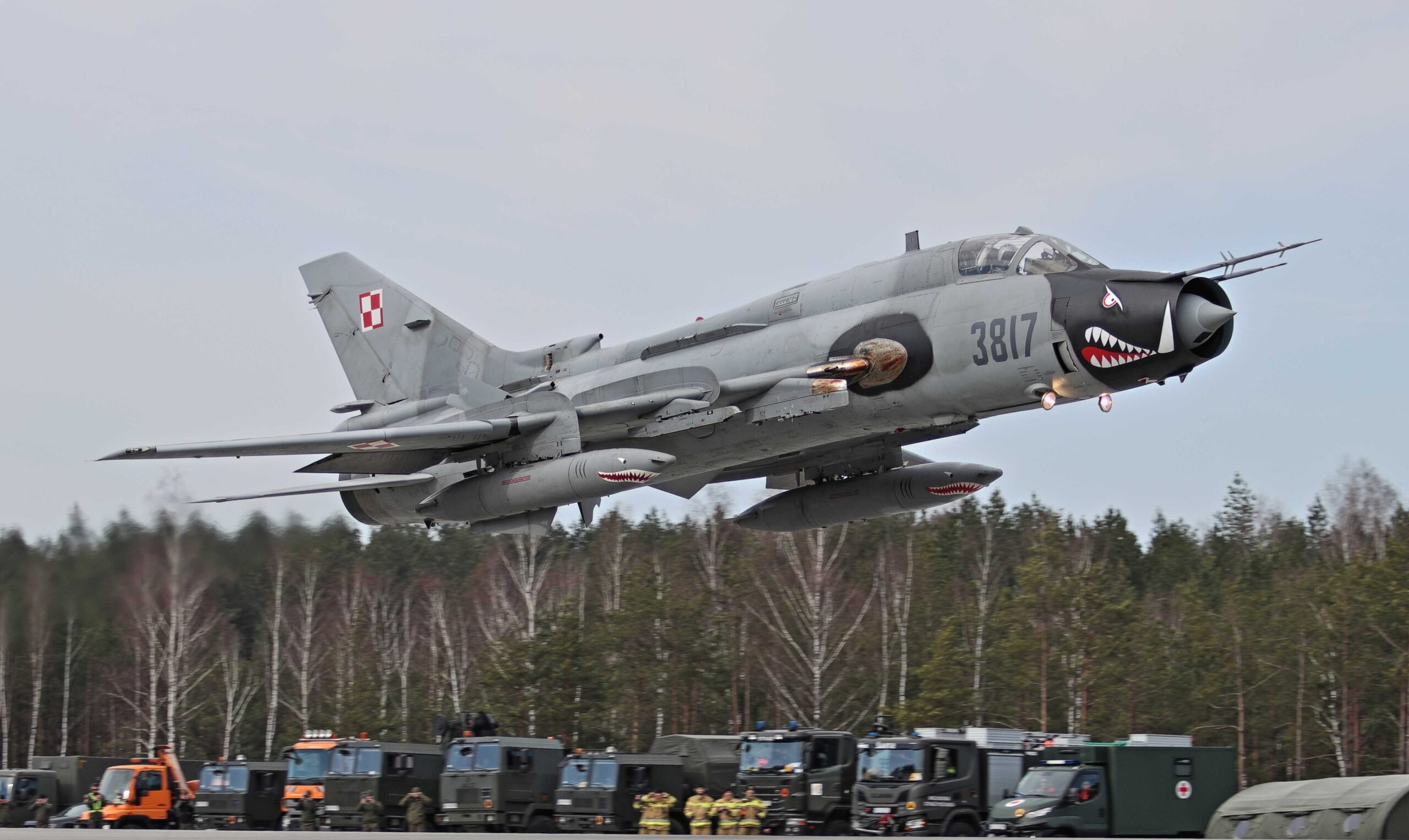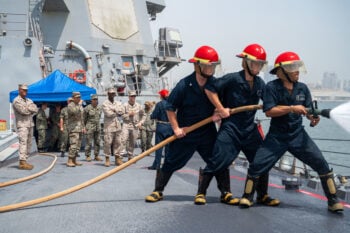
A Polish Su-22 comes in for a landing during the Route 604 exercise. (Iwona Wiszniewska – Klub 1. SLT/MoD)
WARSAW — It is once again an interesting time to be driving on Polish highways.
The Polish Air Force from March 10-14 concluded a military exercise code-named “Route 604,” as part of their ongoing efforts to train both domestic and allied air forces on how to operate jets off of public roads should a Russian invasion take out military airbases. While not the first time this capability has been tested, the most recent version of the exercise featured, for the first time, Italian Eurofighters as well one of Poland’s Turkish-made TB2 drones.
“Route 604” was named because of its use of provincial road no. 604, a public road used daily but which also contains a Drogowy Odcinek Lotniskowy, or DOL — stretches of public roads designated as potential air strips. The particular stretch, DOL Wielbark, is located between the town of Ruskowo and Przeździęk Wielki, southeast of Olsztyn, central Poland.
According to the Poland’s Ministry of National Defence, there are currently 22 DOLs in Poland, but only three are in a condition suitable for operational use. This year’s training at DOL Wielbark was part of the Kondor-2024 exercise, aimed to integrate the units subordinated to the 1st Tactical Aviation Wing.
“The main assumption of this year’s exercise was to check, both in aviation, technical and logistic terms, the possibility of securing the landing of aircraft at DOL, re-establishing of combat readiness and execution of air operations at DOL and all elements directly related to this type of task,” said Lt. Col. Marcin Boruta, spokesman for the 23rd Tactical Aviation Base.
As part of the four-day exercise, MiG-29 Fulcrum fighters from the 22nd Tactical Air Base in Malbork and Su-22 Fitters attack aircraft from the 21st Tactical Air Base in Świdwin, as well as TB-2 Bayraktar unmanned combat aerial vehicle from the 12th Unmanned Aerial Vehicle Base from Mirosławiec, took turns landing and taking off on the commercial strip.
“Unlike last year’s event, pilots flying operationally, carrying out combat duty tasks and reconnaissance flights on a daily basis, were selected to operate at DOL,” said Boruta — giving a more real-world feel to the effort.
On the first day of the exercise, March 10, 4 MiG-29s and 4 Su-22s performed low approach maneuvers and flying over the DOL. The next day, a pair of Fulcrums and four Fitters carried out low approach and touch and go maneuvers. On March 12, 2 MiG-29s and 4 Su-22s performed low approach and touch and go as well as flypast over DOL Wielbark. In addition, a single TB-2 drone operated over the DOL every day.
The final day of the exercise brought a touch of real-world operational challenges. The cloud base was too low, meaning attempts to land by MiG-29s, Su-22 and F-16s were unsuccessful.
Before the start of the exercise at DOL Wielbark, it was announced that Italian Air Force Eurofighter F-2000A multi-role aircraft, currently based at Malbork as part of the Enhanced Air Policing mission, would take part. Unfortunately, the jets did not land on Route 604, only making two low passes, but the sheer concept of bringing in outside jets for this kind of exercise is one that Poland seems keen to repeat.
“Outside the Scandinavian countries, operations with DOL are unique and are trained here in Poland. This is an additional aspect, interesting and worth retraining, [so Italians] having such an opportunity want to take advantage of it and see it. […] Who knows, maybe they will decide that this is an element that they could implement into their training program” Boruta.
TAI exec claims 20 Turkish KAAN fighters to be delivered in 2028
Temel Kotil, TAI’s general manager, claimed that the domestically-produced Turkish jet will outperform the F-35 Joint Strike Fighter.


























